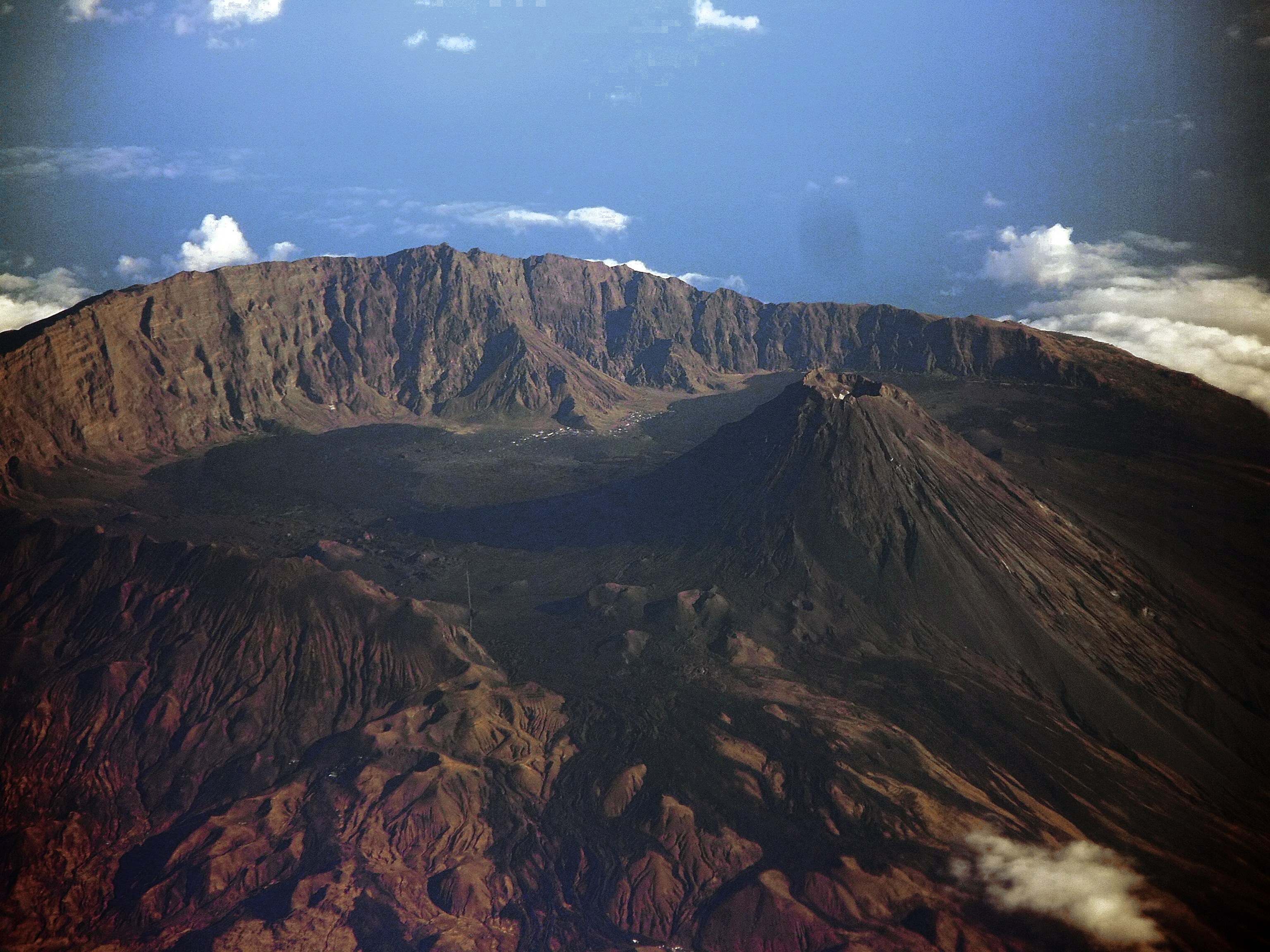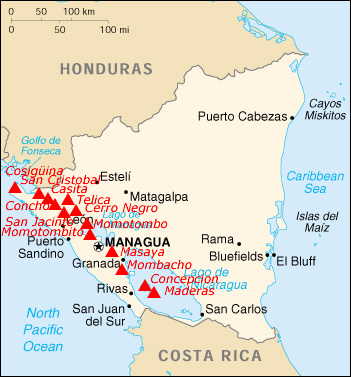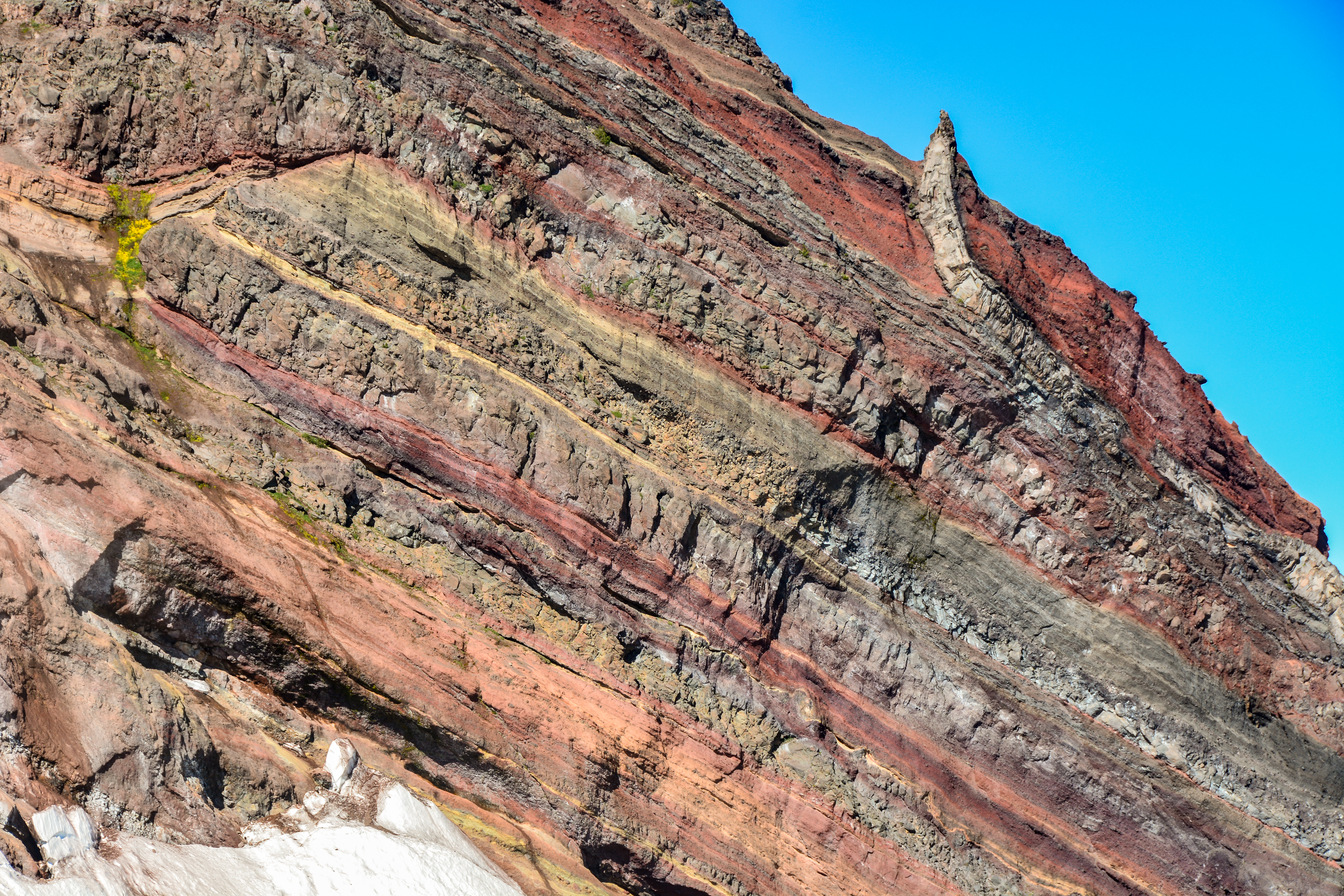|
Cosigüina
Cosigüina (also spelt Cosegüina) is a stratovolcano A stratovolcano, also known as a composite volcano, is a conical volcano built up by many layers (strata) of hardened lava and tephra. Unlike shield volcanoes, stratovolcanoes are characterized by a steep profile with a summit crater and per ... located in the western part of Nicaragua. It forms a large peninsula extending into the Gulf of Fonseca. The summit is truncated by a large caldera, 2 x 2.4 km in diameter and 500 m deep, holding a substantial crater lake (Laguna Cosigüina). This cone has grown within an earlier caldera, forming a somma volcano. The earlier caldera rim is still exposed on the north side, but has been buried by the younger cone elsewhere. Activity The volcano last erupted in 1859, but its most famous activity occurred on January 20, 1835, during the presidency of José Núñez, when it produced the largest historical eruption in Nicaragua. Ash from the 1835 eruption has been foun ... [...More Info...] [...Related Items...] OR: [Wikipedia] [Google] [Baidu] |
José Núñez (President Of Nicaragua)
José Núñez (1800 – 5 March 1880) was a conservative Nicaraguan doctor and politician who served as the 11th, 13th, and 15th Supreme Chief of Nicaragua, and 1st Supreme Director of Independent Nicaragua. Núñez and Joaquín del Cossío were the most important figures in the Independence of Nicaragua, as they began the first and second transitional governments that lead to Nicaragua's independence. Early life Born around the year 1800 in the Solentiname archipelago located in Lake Nicaragua where he spent his early years. Fray Ramón Rojas took him to study in the city of León. Later he traveled to Chile where he graduated with a degree in Medicine and Surgery in the city of Santiago. Back in Nicaragua he practiced his profession in León, and later taught Medicine in the University in that city. As Head of State of Nicaragua First term In December 1833, the administration of Dionisio de Herrera voluntarily ended in advance and was followed temporarily by ad ... [...More Info...] [...Related Items...] OR: [Wikipedia] [Google] [Baidu] |
Volcanic Crater Lake
A volcanic crater lake is a lake in a crater that was formed by explosive activity or a collapse during a volcanic eruption. Formation Lakes in calderas fill large craters formed by the collapse of a volcano during an eruption. Lakes in maars fill medium-sized craters where an eruption deposited debris around a vent. Crater lakes form as the created depression, within the crater rim, is filled by water. The water may come from precipitation, groundwater circulation (often hydrothermal fluids in the case of volcanic craters) or melted ice. Its level rises until an equilibrium is reached between the rates of incoming and outgoing water. Sources of water loss singly or together may include evaporation, subsurface seepage, and, in places, surface leakage or overflow when the lake level reaches the lowest point on its rim. At such a saddle location, the upper portion of the lake is contained only by its adjacent natural volcanic dam; continued leakage through or surface ou ... [...More Info...] [...Related Items...] OR: [Wikipedia] [Google] [Baidu] |
Nicaragua Volcan Cosigüina 5
Nicaragua (; ), officially the Republic of Nicaragua (), is the largest country in Central America, bordered by Honduras to the north, the Caribbean to the east, Costa Rica to the south, and the Pacific Ocean to the west. Managua is the country's capital and largest city. , it was estimated to be the second largest city in Central America. Nicaragua's multiethnic population of six million includes people of mestizo, indigenous, European and African heritage. The main language is Spanish. Indigenous tribes on the Mosquito Coast speak their own languages and English. Originally inhabited by various indigenous cultures since ancient times, the region was conquered by the Spanish Empire in the 16th century. Nicaragua gained independence from Spain in 1821. The Mosquito Coast followed a different historical path, being colonized by the English in the 17th century and later coming under British rule. It became an autonomous territory of Nicaragua in 1860 and its northernmost part ... [...More Info...] [...Related Items...] OR: [Wikipedia] [Google] [Baidu] |
Somma Volcano
A somma volcano (also known as a sommian) is a volcanic caldera that has been partially filled by a new central cone. The name comes from Mount Somma, a stratovolcano in southern Italy with a summit caldera in which the upper cone of Mount Vesuvius has grown. A number of Earth's best examples of somma volcanoes are found on Russia's Kamchatka Peninsula and the Kuril Islands that stretch south from Kamchatka to Hokkaidō (Japan). Some examples of somma volcanoes are the following: * Africa ** Pico do Fogo ( Fogo Island, Cape Verde) ** Teide (Tenerife, Canary Islands, Spain) * Americas ** Cosigüina (Chinandega, Nicaragua) ** Wizard Island (Oregon, United States) ** Lava domes (Mount St. Helens, Washington, United States) * Asia ** Ebeko ( Paramushir Island, Kuril Islands, Russia) ** Gunung Baru Jari ( Segara Anak caldera, Lombok, Indonesia) ** Kolokol Group: Kolokol, Berg, Borzov, Trezubetz ( Urup Island, Kuril Islands, Russia) ** Anak Krakatoa ( Krakatoa archipelago, Su ... [...More Info...] [...Related Items...] OR: [Wikipedia] [Google] [Baidu] |
Nicaragua
Nicaragua (; ), officially the Republic of Nicaragua (), is the largest Sovereign state, country in Central America, bordered by Honduras to the north, the Caribbean Sea, Caribbean to the east, Costa Rica to the south, and the Pacific Ocean to the west. Managua is the country's capital and largest city. , it was estimated to be the List of largest cities in Central America#Largest cities proper, second largest city in Central America. Nicaragua's multiethnic population of six million includes people of mestizo, indigenous, European and African heritage. The main language is Spanish. Indigenous tribes on the Mosquito Coast speak their own languages and English. Originally inhabited by various indigenous cultures since ancient times, the region was conquered by the Spanish Empire in the 16th century. Nicaragua gained independence from Spain in 1821. The Mosquito Coast followed a different historical path, being colonized by the English in the 17th century and later coming under B ... [...More Info...] [...Related Items...] OR: [Wikipedia] [Google] [Baidu] |
List Of Volcanoes In Nicaragua ...
This is a list of active and extinct volcanoes in Nicaragua. Volcanoes See also * Central America Volcanic Arc * List of volcanoes in Costa Rica * List of volcanoes in El Salvador * List of volcanoes in Guatemala * List of volcanoes in Honduras * List of volcanoes in Panama References {{Central American volcanoes Nicaragua Volcanoes A volcano is a rupture in the crust of a planetary-mass object, such as Earth, that allows hot lava, volcanic ash, and gases to escape from a magma chamber below the surface. On Earth, volcanoes are most often found where tectonic plates a ... [...More Info...] [...Related Items...] OR: [Wikipedia] [Google] [Baidu] |
Chinandega Department
Chinandega () is a department in Nicaragua, located on the border with Honduras. It covers an area of 4,822 km2 and has a population of 441,897 (2021 estimate). The capital is the city of Chinandega. Largely agricultural, it produces rum from sugar cane; other products are bananas, peanuts, shrimp and salt. The port of Corinto, in Chinandega, is the most important in Western Nicaragua. Municipalities * Chichigalpa * Chinandega * Corinto * El Realejo * El Viejo * Posoltega * Puerto Morazán * San Francisco del Norte * San Juan de Cinco Pinos * San Pedro del Norte * Santo Tomás del Norte * Somotillo Somotillo is a town and a municipality in the Chinandega department Department may refer to: * Departmentalization, division of a larger organization into parts with specific responsibility Government and military *Department (administrativ ... * Villanueva References Departments of Nicaragua {{Nicaragua-geo-stub ... [...More Info...] [...Related Items...] OR: [Wikipedia] [Google] [Baidu] |
Stratovolcanoes Of Nicaragua
A stratovolcano, also known as a composite volcano, is a conical volcano built up by many layers (strata) of hardened lava and tephra. Unlike shield volcanoes, stratovolcanoes are characterized by a steep profile with a summit crater and periodic intervals of explosive eruptions and effusive eruptions, although some have collapsed summit craters called calderas. The lava flowing from stratovolcanoes typically cools and hardens before spreading far, due to high viscosity. The magma forming this lava is often felsic, having high-to-intermediate levels of silica (as in rhyolite, dacite, or andesite), with lesser amounts of less-viscous mafic magma. Extensive felsic lava flows are uncommon, but have travelled as far as . Stratovolcanoes are sometimes called composite volcanoes because of their composite stratified structure, built up from sequential outpourings of erupted materials. They are among the most common types of volcanoes, in contrast to the less common shield volcanoes. ... [...More Info...] [...Related Items...] OR: [Wikipedia] [Google] [Baidu] |
Volcanic Crater Lakes
A volcano is a rupture in the crust of a planetary-mass object, such as Earth, that allows hot lava, volcanic ash, and gases to escape from a magma chamber below the surface. On Earth, volcanoes are most often found where tectonic plates are diverging or converging, and most are found underwater. For example, a mid-ocean ridge, such as the Mid-Atlantic Ridge, has volcanoes caused by divergent tectonic plates whereas the Pacific Ring of Fire has volcanoes caused by convergent tectonic plates. Volcanoes can also form where there is stretching and thinning of the crust's plates, such as in the East African Rift and the Wells Gray-Clearwater volcanic field and Rio Grande rift in North America. Volcanism away from plate boundaries has been postulated to arise from upwelling diapirs from the core–mantle boundary, deep in the Earth. This results in hotspot volcanism, of which the Hawaiian hotspot is an example. Volcanoes are usually not created where two tectonic plates sl ... [...More Info...] [...Related Items...] OR: [Wikipedia] [Google] [Baidu] |
Calderas Of Central America
A caldera ( ) is a large cauldron-like hollow that forms shortly after the emptying of a magma chamber in a volcano eruption. When large volumes of magma are erupted over a short time, structural support for the rock above the magma chamber is gone. The ground surface then collapses into the emptied or partially emptied magma chamber, leaving a large depression at the surface (from one to dozens of kilometers in diameter). Although sometimes described as a crater, the feature is actually a type of sinkhole, as it is formed through subsidence and collapse rather than an explosion or impact. Compared to the thousands of volcanic eruptions that occur each century, the formation of a caldera is a rare event, occurring only a few times per century. Only seven caldera-forming collapses are known to have occurred between 1911 and 2016. More recently, a caldera collapse occurred at Kīlauea, Hawaii in 2018. Etymology The term ''caldera'' comes from Spanish ', and Latin ', meani ... [...More Info...] [...Related Items...] OR: [Wikipedia] [Google] [Baidu] |
Stratovolcanoes Of El Salvador
A stratovolcano, also known as a composite volcano, is a conical volcano built up by many layers (strata) of hardened lava and tephra. Unlike shield volcanoes, stratovolcanoes are characterized by a steep profile with a summit crater and periodic intervals of explosive eruptions and effusive eruptions, although some have collapsed summit craters called calderas. The lava flowing from stratovolcanoes typically cools and hardens before spreading far, due to high viscosity. The magma forming this lava is often felsic, having high-to-intermediate levels of silica (as in rhyolite, dacite, or andesite), with lesser amounts of less-viscous mafic magma. Extensive felsic lava flows are uncommon, but have travelled as far as . Stratovolcanoes are sometimes called composite volcanoes because of their composite stratified structure, built up from sequential outpourings of erupted materials. They are among the most common types of volcanoes, in contrast to the less common shield volcanoes. ... [...More Info...] [...Related Items...] OR: [Wikipedia] [Google] [Baidu] |






